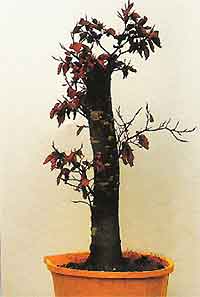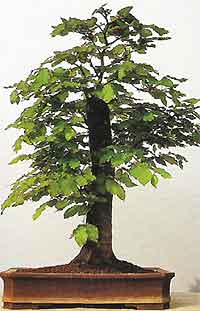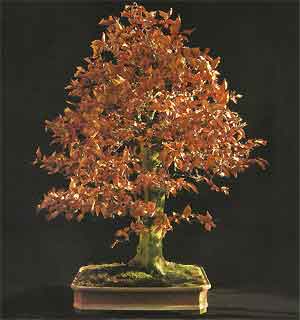Bonsai Trees
Case Histories
European Beech - (fagus sylvatica)
Beech Bonsai Style: Informal Upright

I was walking around a friend's garden one day and mentioned that I was on the lookout for a large beech tree, knowing full well that such as tree was growing amongst other larger trees in a corner of his extensive garden! The tree was being outgrown by the other trees and because of the lack of light had few branches.
He immediately thought of this tree and kindly said that if I was prepared to help him dig it up, I could take it home with me that afternoon. I investigated the beech and although it had a general lack of taper, it did have the signs of a good buttress. The trunk was slightly fluted and being late autumn it could be lifted safely, the only problem was the tree's size.
At around 4 1/2 metres (15 feet) in height and growing in close proximity to other larger trees I thought that its removal was likely to be a project. I was right! After half and hour of carefully digging deeply around the trunk, the tree still remained firmly in the stony ground. Stronger measures were needed and my friend decided that maybe leverage would be the answer and started to climb up the tree! As he swayed backwards and forwards near the top, his extra weight helped to loosen the roots and the tree soon uprooted with my friend jumping to safety!

I would not recommend this method, however, as there are obvious dangers, both to the person and the tree! The trunk was shortened by sawing through at a suitable point, leaving no branches and the ripped roots were pruned. I returned home and immediately planted the stump in a sunny area of my garden and wondered what the spring would bring.
Beech Bonsai History: Training
After most of my bonsai trees had begun to leaf out in the spring, the beech stump showed no signs of life. I was convinced that it was dead and scratched the trunk to remove a small amount of bark, revealing that it was still green underneath and very much alive. Several weeks later I was thrilled when I noticed buds beginning to form. There were not many, but they were well spaced up the trunk and I began to see possibilities. Over the next few months the new buds opened and the shoots grew strongly. The leaves were a rich green and the beech started to look very healthy, remaining so for the rest of the year.

As the tree had grown so well the previous year I decided to begin its training in a pot. When spring arrived I planted it in a rather 'attractive' yellow bucket. Later that year, after the shoots had extended they were partly wired for the first time. There were only five main branches and these were positioned reaching upwards and allowed to grow unchecked, so that each branch would fill in the large spaces between.
The beech remained in the bucket for two years until it began to resemble a tree. I decided that it warranted a bonsai pot and in the spring examined the roots to see if it would tolerate a much shallower pot. The roots had grown well and the bucket was full of fibrous roots, which had even grown through the polystyrene layer that filled the lower half of the bucket.
I pruned the largest downward roots and was left with a good, evenly distributed root system that allowed the tree to be planted in the large, rectangular bonsai pot that I had chosen. The pot matched the tree well, with plenty of room for the roots to grow and the overall appearance was very satisfying. I did not realise quite how suitable the pot colour was until the following autumn, when the colour perfectly matched the dried up autumnal leaves that the beech retains throughout winter.
One year later and with the beech now growing strongly, it was time to wire the branches further. A well rounded crown helped the tree appear mature and it began to look very natural.
Two years on and the ramification of the fine branches has been allowed to develop slowly. The tree is fed only lightly and the new spring shoots are pinched as the apical buds unfurl, helping to create a more twiggy structure. My friend has watched this tree's development with interest and has assured me that he will not attempt to climb it again!
 I was walking around a friend's garden one day and mentioned that I was on the lookout for a large beech tree, knowing full well that such as tree was growing amongst other larger trees in a corner of his extensive garden! The tree was being outgrown by the other trees and because of the lack of light had few branches.
I was walking around a friend's garden one day and mentioned that I was on the lookout for a large beech tree, knowing full well that such as tree was growing amongst other larger trees in a corner of his extensive garden! The tree was being outgrown by the other trees and because of the lack of light had few branches. I would not recommend this method, however, as there are obvious dangers, both to the person and the tree! The trunk was shortened by sawing through at a suitable point, leaving no branches and the ripped roots were pruned. I returned home and immediately planted the stump in a sunny area of my garden and wondered what the spring would bring.
I would not recommend this method, however, as there are obvious dangers, both to the person and the tree! The trunk was shortened by sawing through at a suitable point, leaving no branches and the ripped roots were pruned. I returned home and immediately planted the stump in a sunny area of my garden and wondered what the spring would bring. As the tree had grown so well the previous year I decided to begin its training in a pot. When spring arrived I planted it in a rather 'attractive' yellow bucket. Later that year, after the shoots had extended they were partly wired for the first time. There were only five main branches and these were positioned reaching upwards and allowed to grow unchecked, so that each branch would fill in the large spaces between.
As the tree had grown so well the previous year I decided to begin its training in a pot. When spring arrived I planted it in a rather 'attractive' yellow bucket. Later that year, after the shoots had extended they were partly wired for the first time. There were only five main branches and these were positioned reaching upwards and allowed to grow unchecked, so that each branch would fill in the large spaces between.